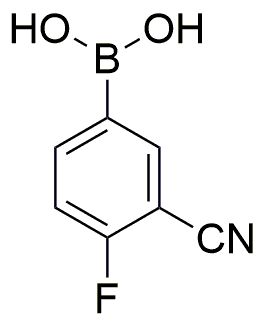3-Cyano-4-fluorophenylboronic acid is widely utilized in research focused on:
- Pharmaceutical Development: This compound serves as a key intermediate in the synthesis of various pharmaceuticals, particularly in the development of anti-cancer agents. Its unique structure allows for targeted modifications that enhance drug efficacy.
- Organic Synthesis: It is an important reagent in cross-coupling reactions, such as Suzuki-Miyaura coupling, which is widely used in the creation of complex organic molecules. This application is crucial for researchers in the fields of materials science and organic chemistry.
- Fluorescent Probes: The compound can be utilized in the development of fluorescent probes for biological imaging. Its ability to bind selectively to certain biomolecules makes it valuable in cellular and molecular biology studies.
- Sensor Technology: 3-Cyano-4-fluorophenylboronic acid is effective in the fabrication of sensors for detecting sugars and other biomolecules. This application is particularly relevant in the food industry and medical diagnostics.
- Environmental Monitoring: The compound can be used in analytical chemistry for the detection of pollutants. Its sensitivity and specificity make it suitable for monitoring environmental contaminants, aiding in compliance with regulatory standards.
General Information
Properties
Safety and Regulations
Applications
3-Cyano-4-fluorophenylboronic acid is widely utilized in research focused on:
- Pharmaceutical Development: This compound serves as a key intermediate in the synthesis of various pharmaceuticals, particularly in the development of anti-cancer agents. Its unique structure allows for targeted modifications that enhance drug efficacy.
- Organic Synthesis: It is an important reagent in cross-coupling reactions, such as Suzuki-Miyaura coupling, which is widely used in the creation of complex organic molecules. This application is crucial for researchers in the fields of materials science and organic chemistry.
- Fluorescent Probes: The compound can be utilized in the development of fluorescent probes for biological imaging. Its ability to bind selectively to certain biomolecules makes it valuable in cellular and molecular biology studies.
- Sensor Technology: 3-Cyano-4-fluorophenylboronic acid is effective in the fabrication of sensors for detecting sugars and other biomolecules. This application is particularly relevant in the food industry and medical diagnostics.
- Environmental Monitoring: The compound can be used in analytical chemistry for the detection of pollutants. Its sensitivity and specificity make it suitable for monitoring environmental contaminants, aiding in compliance with regulatory standards.
Documents
Safety Data Sheets (SDS)
The SDS provides comprehensive safety information on handling, storage, and disposal of the product.
Product Specification (PS)
The PS provides a comprehensive breakdown of the product’s properties, including chemical composition, physical state, purity, and storage requirements. It also details acceptable quality ranges and the product's intended applications.
Certificates of Analysis (COA)
Search for Certificates of Analysis (COA) by entering the products Lot Number. Lot and Batch Numbers can be found on a product’s label following the words ‘Lot’ or ‘Batch’.
*Catalog Number
*Lot Number
Certificates Of Origin (COO)
This COO confirms the country where the product was manufactured, and also details the materials and components used in it and whether it is derived from natural, synthetic, or other specific sources. This certificate may be required for customs, trade, and regulatory compliance.
*Catalog Number
*Lot Number
Safety Data Sheets (SDS)
The SDS provides comprehensive safety information on handling, storage, and disposal of the product.
DownloadProduct Specification (PS)
The PS provides a comprehensive breakdown of the product’s properties, including chemical composition, physical state, purity, and storage requirements. It also details acceptable quality ranges and the product's intended applications.
DownloadCertificates of Analysis (COA)
Search for Certificates of Analysis (COA) by entering the products Lot Number. Lot and Batch Numbers can be found on a product’s label following the words ‘Lot’ or ‘Batch’.
*Catalog Number
*Lot Number
Certificates Of Origin (COO)
This COO confirms the country where the product was manufactured, and also details the materials and components used in it and whether it is derived from natural, synthetic, or other specific sources. This certificate may be required for customs, trade, and regulatory compliance.


